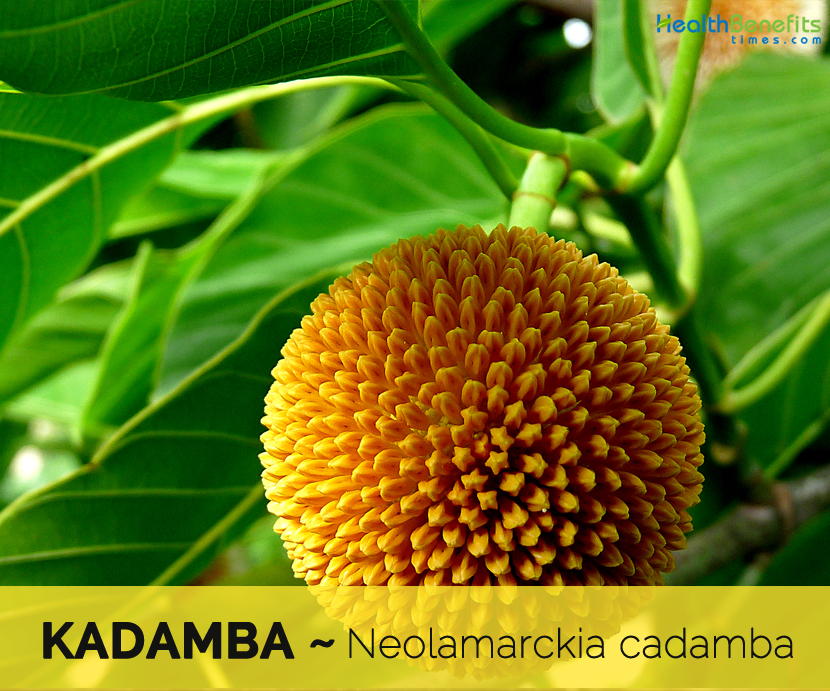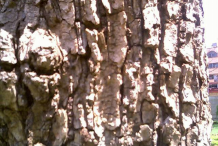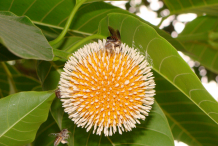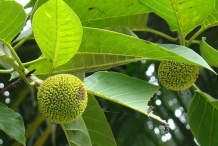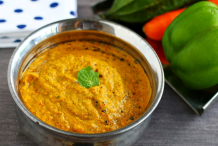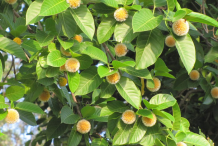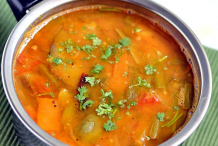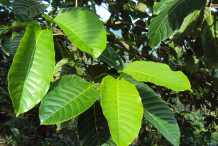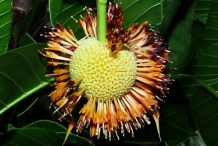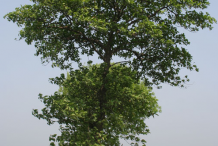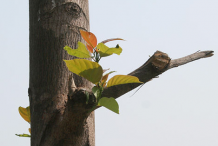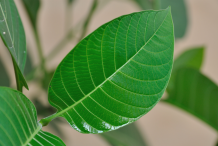Description
Kadamba tree is an evergreen, tropical tree that can reach up to 45 m (148 ft.) in height. It is a large tree with a broad crown and straight cylindrical bole. It is quick growing, with broad spreading branches and grows rapidly in the first 6–8 years. The trunk has a diameter of 100–160 cm, but typically less than that. Bark is dark grey in color, rough and frequently longitudinally fissured, exfoliating in thin scales. Leaves are glossy green, opposite, simple more or less sessile to petiolate, ovate to elliptical, 30 cm long 10-15 cm broad with prominent veins. Flowering usually begins when the tree is 4–5 years old. Kadam flowers are sweetly fragrant, red to orange in color, occurring in dense, globular heads of approximately 5.5 cm (2.2 in) diameter. Fruits are round like small balls, hard containing approximately 8000 seeds and are green when young turning to yellow when ripe. Seeds are trigonal or irregularly shaped.
Health benefits of Kadamba
Kadamba (Neolamarckia Cadamba) is an ayurvedic medicine used for treating diabetes. It is also beneficial for the management of infections caused by a range of organisms. This herb is known to possess strong medicinal properties, which help to improve the health of the person. Listed below are few of the health benefits of Kadamba
1. Anti-diabetic activity
Frequent use of Kadamba is highly beneficial for the patients suffering from diabetes mellitus. It is a metabolic disorder characterized by increased levels of blood sugar due to the alterations in the metabolism of carbohydrates.
It occurs due to the reduced production of insulin in the pancreas or the inability of the body’s cells to respond to the insulin in an appropriate way. As a result of these abnormalities, the carbohydrates consumed by the person cannot be metabolized leading to high blood sugar levels.
2. Cancer
Kadamba produces a significant antitumor activity. It is used in the management of several forms of cancer including prostate cancer, colon cancer, breast cancer, and esophageal cancer.
Cancer occurs due to the propagation of the abnormal cells in any organ in an uncontrolled way. These abnormal cells have a high tendency to spread to the surrounding as well as the distant healthy tissues resulting in the spread of cancer.
Kadamba can help in treating this disease by limiting the growth of the cancer cells. It also prevents their spread. It contains several bioactive compounds that produce an action similar to that of the chemotherapeutic agents.
3. Fungal infections
Kadamba produces a strong antifungal action. It can be used to treat fungal infections of the skin, and ears. The extract of the leaf and bark of this herb produce an antifungal activity, which helps to eliminate the fungi. It can also be used to treat infections caused due to a wide range of fungi including Candida Albicans and Aspergillus Fumigatus.
4. Musculo-skeletal diseases
Kadamba is quite beneficial to treat the joint and muscle disorders like arthritis, muscle stiffness, and rheumatism. It acts as a natural analgesic and anti-inflammatory agent. It contains flavonoids like quercetin, daidzein, silymarin apigenin, and genistein, which help to provide relief from the pain and stiffness caused due to the musculoskeletal disorders.
Kadamba prevents the worsening of the joint diseases by preventing inflammation and the age-related wear and tear of the joints. The active constituents in Kadamba also reduce swelling in the joints and ease the movements.
5. Antibacterial activity
Kadamba can be used to treat infections caused due to bacteria. It helps to treat infections in the skin, digestive tract, nervous system, bones, eyes, and ears.
Aqueous extract of Kadamba fruit has shown significant antibacterial activity against a range of microorganisms like Staphylococcus Aureus, Pseudomonas Aeruginosa, Escherichia Coli, Micrococcus Luteus, Staphylococcus Aureus, Bacillus Subtilis, Pseudomonas Aeruginosa, Klebsiella Pneumonia, Salmonella Typhi, and Proteus Mirabilis.
6. High cholesterol and triglycerides
Kadamba is used to reduce the cholesterol and triglyceride levels. The increased cholesterol and triglycerides levels result in the deposition of plaques in the inner walls of the blood vessels making them narrower. As a result, the blood flow to the vital organs such as the heart and brain is affected thus increasing the risk of myocardial infarction, and stroke.
7. Parasitic infection
Kadamba produces an anthelminthic activity, which has been proved during research. This herb is effective in the management of several parasitic infections including roundworm, tapeworm, pinworm, and threadworm.
Parasitic infections occur due to the unhygienic habits and the consumption of contaminated foods. A regular use of Kadamba helps to prevent the recurrent parasitic infections by enhancing the immunity of the person. It can also help to reduce the symptoms of these infections such as pain in the abdomen, nausea, vomiting, loose motions, and reduced appetite.
8. Digestive disturbances
Kadamba can be used to treat the symptoms caused due to the digestive disturbances such as loose motions, abdominal cramps, and vomiting.
Traditional uses and benefits of Kadamba
- Paste of the leaves of kadamba are tied over the wound or area affected with localized pain and swelling to reduce the complaints.
- Decoction of the bark of Neolamarckia cadamba is used to wash the infected wound.
- Decoction of the bark of the plant is used for gargling to treat mouth ulcers and inflammation of the gums.
- Decoction of kadamba is taken in a dose of 30-40 ml to treat diarrhea and irritable bowel syndrome.
- Powder of the bark of the tree is given with sugar candy in a dose of 5-6 g to treat nausea and vomiting.
- Juice of the fruit of kadamba is given in a dose of 40-50 ml to treat excessive sweating, thirst and burning sensation of the body.
- Decoction of the root of Neolamarckia cadamba is taken in dose of 30-40 ml to treat urinary tract infection and renal calculi.
- Decoction of the bark of the tree is consumed in a dose of 30-40 ml to treat fever.
- Paste of the bark of kadamba is applied over black spots and pimples.
- Fresh juice of the leaf is consumed in a dose of 10-15 ml to treat leucorrhoea and increased menstrual flow.
- Fresh juice of the fruit is useful to increase the breast milk in lactating women.
- Paste prepared from the bark of stem and leaf of kadamba is useful to treat pain, redness and itching due to insect bite.
- An extract of the leaves serves as a mouth gargle.
- Decoction of bark skin is an effective remedy for diarrhea, dysentery and colitis.
- Juice of bark skin combined with cumin seeds and sugar alleviates vomiting.
- Excessive thirst in fevers is quenched with its fruit juice.
- Decoction of roots is salutary in urinary ailments like dysuria, urinary calculi and glycosuria.
- Menorrhagia is effectively controlled with the fresh juice of its leaves or their decoction.
- In traditional medicine in the Indian subcontinent the bark and roots of the tree are used for fevers, colic, muscular pains, burning sensations in the stomach, poisoning, female problems, coughs, oedema and as an aphrodisiac.
- In Ayurvedic medicine the bark of the tree is used for blood-related diseases.
- Kadamba tree leaves are used for curing diabetes.
Other Facts
- Flowers are used in perfumes.
- Tree is grown as an ornamental plant.
- Timber is used for plywood, light construction, pulp and paper, boxes and crates, dug-out canoes, and furniture components.
- Tree is grown along avenues, roadsides and villages for shade.
- Kadamba are suitable for reforestation programs.
- A yellow dye is obtained from the root bark.
- Kadamba flowers are an important raw material in the production of ‘attar’, which is Indian perfume with sandalwood base.
- Kadamba tree was considered a holy tree by the Kadamba dynasty.
- The fresh leaves are sometimes used as serviettes or plates.
- The flowers are the source of an essential oil.
Kadamba Facts
The Cadamba is one of the important medicinal plants belonging to the Rubiaceae family. A large tree with a broad crown, and straight cylindrical bole, Kadamba is quick growing, with broad spreading branches. The flower of the tree is red to orange in color, occurring in dense, globe-like head. It nicely assumes the shape of a ball. When the tree is in bloom, one can see the tree loaded with numerous beautiful flowers. The flowering usually begins when the tree is 4–5 years old. It is an evergreen tropical tree found in different parts of India, Bangladesh, Nepal, Myanmar, Sri Lanka, Cambodia, Laos, Philippines, Malaysia, Indonesia, Papua New Guinea, and Australia. etc.
| Kadamba Tree (Burflower) Quick Facts | |
|---|---|
| Name: | Kadamba Tree (Burflower) |
| Scientific Name: | Neolamarckia cadamba |
| Origin | South and Southeast Asia |
| Colors | Green when young turning to yellow when ripe |
| Shapes | Round like small balls, hard containing approximately 8000 seeds. |
| Taste | Sweet and sour |
| Health benefits | Digestive disturbances, Parasitic infection, High cholesterol and triglycerides, Antibacterial activity, Musculoskeletal diseases, Fungal infections, Cancer, Anti-diabetic activity |
| Name | Kadamba Tree (Burflower) |
|---|---|
| Scientific Name | Neolamarckia cadamba |
| Native | South and Southeast Asia |
| Common Names | Burflower-tree, laran, Leichhardt pine, kadam |
| Name in Other Languages | Arabic: Kadam (كادام ) Assamese: Kadama(কদম), Raghu(ৰঘু ) Bengali: Kadamgach, Kadama (কদম), Kadamba (কদম্ব ), Kadami, Nipa(নীপ) . Brunei Darussalam: Bangkal, kaatoan bangkal Burmese: Mau Chinese: Dà yè huáng liángmù (大叶黄梁木 ) English: Burflower tree, common bur-flower-tree, Leichhardt pine, laran, kadam, Chinese anthocephalus, White jabon, Wild cinchona, Wild cinchona tree, Wild quinine, Yellow cheesewood German: Kadamb Guajarati: Kadamb (કદંબ) Hindi: Kadam, Kadamb(कदम्ब ), Kadamba, Kadamba vr̥kṣa (कदंब वृक्ष ) Indonesia: Kalempajan Italian: Kadam, Kadamba Java: Jabon Japanese: Kadamu (カダム) Kalimantan: Laran Kannada: Apathyada mara, Dhaaruja kaare, Etthakada, Hellthaega, Kaada balige, Kadam, Kadamba (ಕದಂಬ), Kadamba mara, Kaddabailu, Kadubale, Kadubalige, Kaduve, Kada pode, Kadahada mara, Kadayaala, Kadavala, Kāḍu kvinain (ಕಾಡು ಕ್ವಿನೈನ್ ), Kadwal, Kalamb, Kodawaala, Kodeyaala, Kodivaala, Neeronje, Nhiv, Nirmavina, Niv Laos: Koo-somz, mai sa kho, sako Malay: Emajang (Indonesia), Jabon (Java), Jabon putih (Indonesia), Laran (Indonesia), Kelampajang (Indonesia), Kelampayan, Kelempai, Kelempayan, Kelumpang, Kepayang kayu, Lempayang, Selimpoh. Malayalam: Aṟṟutēkk (ആറ്റുതേക്ക്), Attutek, Attuttekka, Atuthekku, Cakka, Chakka, Kadamba (കദംബ ), Kadambu, Kadavara, Katamba, Katampa (കടമ്പ് ), Katarvayura, Katousjaka, Kattuccakka, Kattuchakka, Nipam, Shakka, Vellacadambe, Vellakatampa Marathi: Rajakadamba, Kadam, Kadamb (कदंब ), Kadamba vr̥kṣa (कदंब वृक्ष ), Kaḷamba (कळंब), Nhiv (नीव) Myanmar: Mau, maukadon, mau-lettan-she, yemau Nepalese: Kadam Oriya: Kadamba (କଦମ୍ବ), Priyakah Papua New Guinea: Labula Peninsular Malaysia: Kalempayan Philippines: Kaatoan bangkal Polish: Kadamba Russian: Antotsefalotus (Антоцефалотус) Sabah: Laran Sarawak: Selimpoh Sanskrit: Ashokari, Dhara-kadambo, Dhārākadambaḥ (धाराकदम्बः), Dhulikadambah, Gandhavatpushpa, Girikadambakah, Halipriya, Haripriya (हरिप्रिय), Kadamba (कदम्ब), Kadambaryya, Kadambari, Karnapurak, Karnapuraka, Kutsitamba, Kutsitangah, Lalanapriya, Mahadhya, Nadija, Nipah, Pravrishenya, Priyaka, Rajakadambah, Shatpadeshta, Sindhupushpa, Vrattapuspa, Vrittapushpa Sinhalese: Ambulbakmi, bakmī (බක්මී) Bakamaī Sri Lanka: Kola-aiyila, vella cadamba, vellai-cadamba Sumatra: Emajang Tagalog: Kaatoan bangkal Tamil: Camuttirappalai, Cumpulimaram, Intumarimaram, Intuvalam, Kadambu, Kadappai, Kalampam, Kapam, Karanapurakkiyam, Karnapurakam, Katampacivam, Katampam (கடம்பம்), Kaṭampu (கடம்பு), Kaṭampa maram (கடம்ப மரம் ), Kathambu, Kokalamaram, Kola aiyila, Kolayilal, Kuyilenamaram, Makatturumam, Marakatampam, Paratiki, Pirettam, Potulimaram, Ruttiratcakatampu, Tacavirutcam, Tarakatampam, Tarakatampamaram, Vella-kadamba, Vellaikkadambu, Vellaikkatampai, Vellaikkatampu (வெள்ளை கதம்பு ), Vicalam, Viruttaputpam Telegu: Begada, Kadamba (కదంబ), Kadambakamu, Kadambamu (కదంబము), Kadambe, Kaḍimi (కడిమి), Mogulu kadimi, Neepamu, Neerpaala kadambamu, Nipamu, Nripalakadambamu, Peddakambo, Prenkhanamu, Priyakamu, Rudraakshakamba, Rudrakshkamba Thai: Krathùm (กระทุ่ม), Krathum bok, Takoo, chantanaburi; krathum, nakhon si tham arrat, sukhothai Vietnamese: Cây Gáo trắng, Gáo tàu, Cà tôm, Cà đam |
| Plant Growth Habit | Evergreen, tropical tree |
| Soil | Grow best in alluvial sites like river-banks and in the transitional zone between swampy, permanently flooded and periodically flooded areas. |
| Plant Size | 45 m (148 ft.) in height |
| Bark | Dark grey in color, rough and frequently longitudinally fissured, exfoliating in thin scales. |
| Trunk | Diameter of 100-160 cm, |
| Leaf | Glossy green, opposite, simple more or less sessile to petiolate, ovate to elliptical, 30 cm long 10-15 cm broad with prominent veins |
| Flower | Sweetly fragrant, red to orange in color, occurring in dense, globular heads of approximately 5.5 cm (2.2 in) diameter. |
| Fruit Shape & Size | Round like small balls, hard containing approximately 8000 seeds. |
| Fruit Color | Green young turnong to yellow when ripe |
| Taste | Sweet and sour |
| Seed | Trigonal or irregularly shaped. |
| Health Benefits |
|
References:
http://davesgarden.com/guides/pf/go/142693/
https://npgsweb.ars-grin.gov/gringlobal/taxonomydetail.aspx?410705
https://www.itis.gov/servlet/SingleRpt/SingleRpt?search_topic=TSN&search_value=565321#null
https://plants.usda.gov/core/profile?symbol=neca7
https://www.ncbi.nlm.nih.gov/pmc/articles/PMC4557232/
https://en.wikipedia.org/wiki/Neolamarckia_cadamba
http://www.cabi.org/isc/datasheet/5243
http://religion.wikia.com/wiki/Kadamba_tree
Comments
comments
